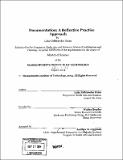| dc.contributor.advisor | Walter Bender. | en_US |
| dc.contributor.author | Ouko, Luke Odhiambo | en_US |
| dc.contributor.other | Massachusetts Institute of Technology. Dept. of Architecture. Program in Media Arts and Sciences. | en_US |
| dc.date.accessioned | 2006-02-02T18:55:37Z | |
| dc.date.available | 2006-02-02T18:55:37Z | |
| dc.date.copyright | 2004 | en_US |
| dc.date.issued | 2005 | en_US |
| dc.identifier.uri | http://hdl.handle.net/1721.1/31175 | |
| dc.description | Thesis (S.M.)--Massachusetts Institute of Technology, School of Architecture and Planning, Program in Media Arts and Sciences, June 2005. | en_US |
| dc.description | Includes bibliographical references (leaves 107-112). | en_US |
| dc.description.abstract | The Center for Reflective Community Practice in MIT's Department of Urban studies is involved in projects helping community organizers working on social change. In order to foster reflection, they are currently utilizing what they refer to as "Critical Moments Reflection". This method entails the identification and naming of key shifts or turning points (critical moments) in the process of the community organizers' work. To drive learning through reflection, they use stories relevant to the turning points, they then analyze those moments using a pre-specified genre of poignant questions. I have created an application, the CMReflector, that aids in the process of Critical Moments Reflection. It will facilitate the process of documentation by utilizing some of the rich computational tools that we now have access to. Since the learning that people acquire through their work stays largely under the surface, there is need to systematically examine the lessons learned and articulate the knowledge and questions that have come out of such work. The application provides an organizational structure and taxonomy around which to compile tacit knowledge and its representation, allowing for exploration of such knowledge in a richer fashion. In order to leverage the use of archived materials, tools such as TalkTV (an application that re-sequeces television content) have been used to augment my application allowing for a "low floor" entry to multiple media editing by the users. It is envisaged that these tools aid in bringing forth the intrinsic "ifs" and "thens," as well as generating the potential for serendipitous learning experiences. All this is very useful in bringing some form of rigor into the practice of reflective inquiry. | en_US |
| dc.description.statementofresponsibility | by Luke Odhiambo Ouko. | en_US |
| dc.format.extent | 112 leaves | en_US |
| dc.format.extent | 5240980 bytes | |
| dc.format.extent | 5254688 bytes | |
| dc.format.mimetype | application/pdf | |
| dc.format.mimetype | application/pdf | |
| dc.language.iso | eng | en_US |
| dc.publisher | Massachusetts Institute of Technology | en_US |
| dc.rights | M.I.T. theses are protected by copyright. They may be viewed from this source for any purpose, but reproduction or distribution in any format is prohibited without written permission. See provided URL for inquiries about permission. | en_US |
| dc.rights.uri | http://dspace.mit.edu/handle/1721.1/7582 | |
| dc.subject | Architecture. Program in Media Arts and Sciences. | en_US |
| dc.title | Documentation : a reflective practice approach | en_US |
| dc.type | Thesis | en_US |
| dc.description.degree | S.M. | en_US |
| dc.contributor.department | Program in Media Arts and Sciences (Massachusetts Institute of Technology) | |
| dc.identifier.oclc | 61240974 | en_US |
